链表
单链表
使用数组来进行单链表的操作、
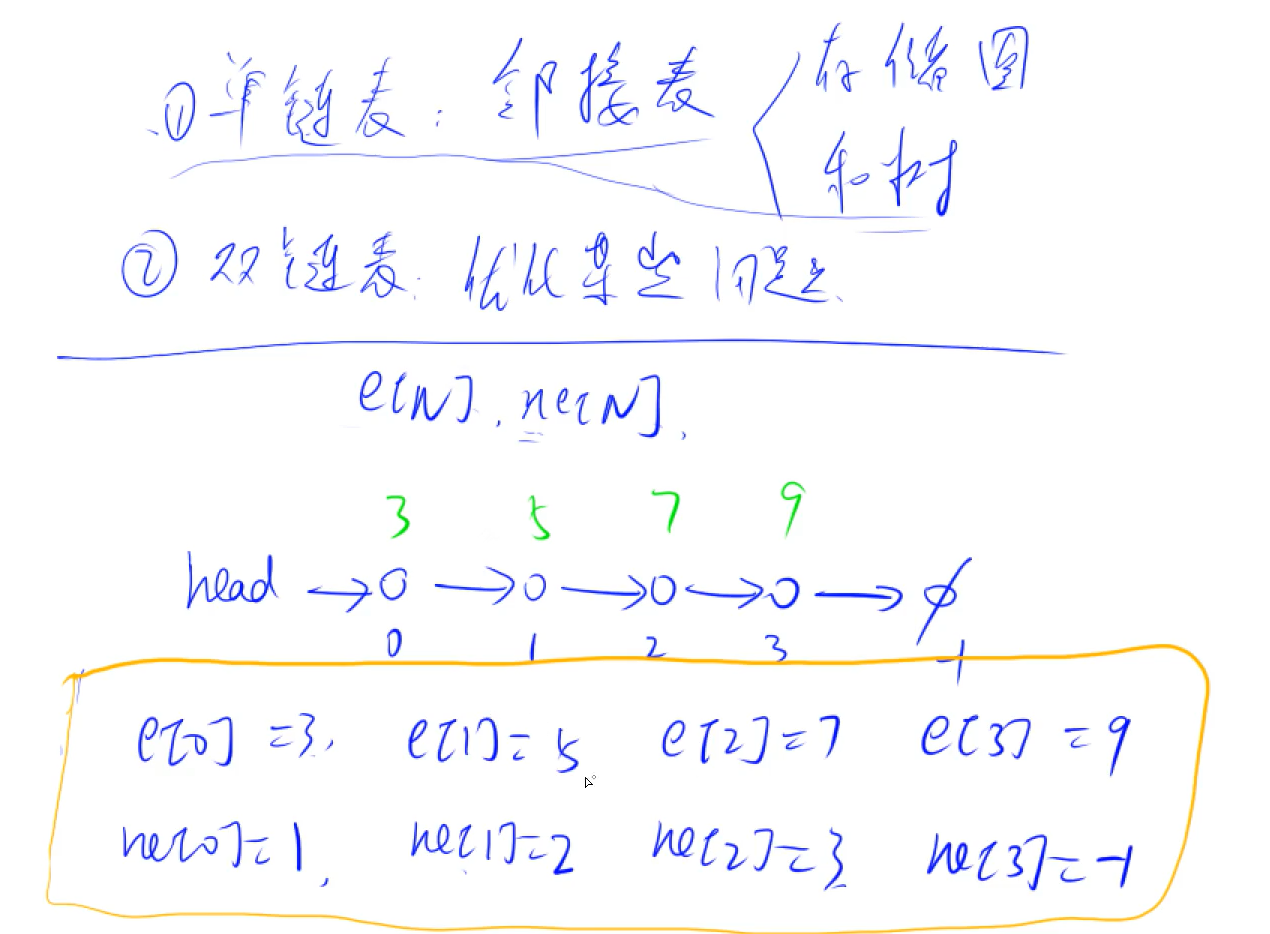
模板:
1
2
3
4
5
6
7
8
9
10
11
12
13
14
15
16
17
18
19
20
21
22
23
24
25
26
27
28
29
30
31
32
33
34
| static int N = 100010;
static int e[] = new int[N];
static int ne[] = new int[N];
static int idx;
static int head;
public static void init(){
head = -1;
idx = 0;
}
public static void addHead(int a){
e[idx] = a;
ne[idx] = head;
head = idx;
idx++;
}
public static void add(int k,int a){
e[idx] = a;
ne[idx] = ne[k];
ne[k] = idx;
idx++;
}
public static void remove(int k){
ne[k] = ne[ne[k]];
}
|
例题:
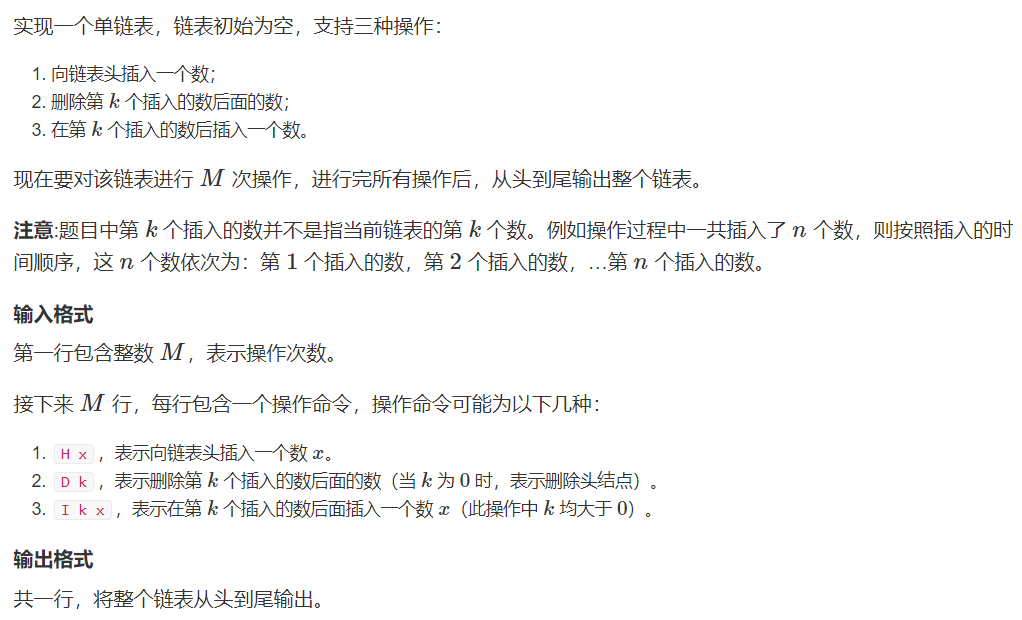
代码为:
1
2
3
4
5
6
7
8
9
10
11
12
13
14
15
16
17
18
19
20
21
22
23
24
25
26
27
28
29
30
31
32
33
34
35
36
37
38
39
40
41
42
43
44
45
46
47
48
49
50
51
52
53
54
55
56
57
58
59
60
61
62
63
| import java.util.*;
import java.io.*;
public class Main{
static int N = 100010;
static int e[] = new int[N];
static int ne[] = new int[N];
static int idx;
static int head;
public static void init(){
head = -1;
idx = 0;
}
public static void addHead(int a){
e[idx] = a;
ne[idx] = head;
head = idx;
idx++;
}
public static void add(int k,int a){
e[idx] = a;
ne[idx] = ne[k];
ne[k] = idx;
idx++;
}
public static void remove(int k){
ne[k] = ne[ne[k]];
}
public static void main(String[] args) throws Exception {
BufferedReader br = new BufferedReader(new InputStreamReader(System.in));
PrintWriter pw = new PrintWriter(new BufferedWriter(new OutputStreamWriter(System.out)));
int n = Integer.parseInt(br.readLine()) ;
init();
while (n-->0){
String s[] = br.readLine().split(" ");
char p = s[0].charAt(0);
if (p=='H'){
int a = Integer.parseInt(s[1]);
addHead(a);
}else if (p=='D'){
int k = Integer.parseInt(s[1]);
if (k==0) head = ne[head];
else remove(k-1);
}else {
int k = Integer.parseInt(s[1]);
int a = Integer.parseInt(s[2]);
add(k-1,a);
}
}
for (int i = head;i!=-1;i=ne[i]){
pw.print(e[i]+" ");
}
pw.flush();
}
}
|
双链表
模板;
1
2
3
4
5
6
7
8
9
10
11
12
13
14
15
16
17
18
19
20
21
22
|
public static void init(){
r[0] = 1;
l[1] = 0;
idx = 2;
}
public static void add(int k,int a){
e[idx] = a;
l[idx] = k;
r[idx] = r[k];
l[r[k]] = idx;
r[k] = idx;
idx++;
}
public static void delete(int k){
l[r[k]] = l[k];
r[l[k]] = r[k];
}
|
例题:
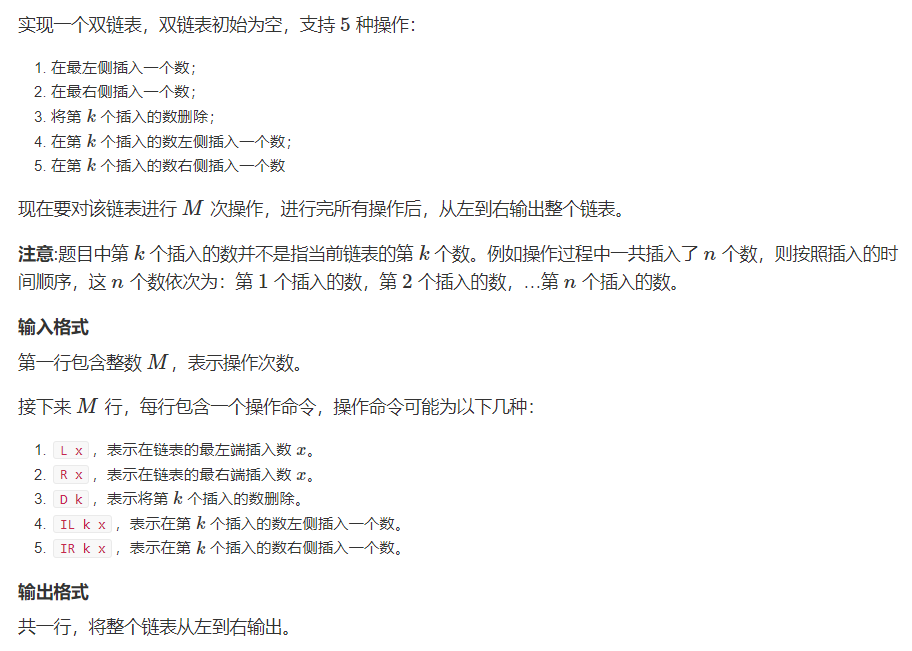
代码为:
1
2
3
4
5
6
7
8
9
10
11
12
13
14
15
16
17
18
19
20
21
22
23
24
25
26
27
28
29
30
31
32
33
34
35
36
37
38
39
40
41
42
43
44
45
46
47
48
49
50
51
52
53
54
55
56
57
58
59
60
61
62
63
| import java.io.*;
import java.util.*;
public class Main{
static int N = 100010;
static int e[] = new int[N];
static int l[] = new int[N];
static int r[] = new int[N];
static int idx;
public static void init(){
r[0] = 1;
l[1] = 0;
idx = 2;
}
public static void add(int k,int a){
e[idx] = a;
l[idx] = k;
r[idx] = r[k];
l[r[k]] = idx;
r[k] = idx;
idx++;
}
public static void delete(int k){
l[r[k]] = l[k];
r[l[k]] = r[k];
}
public static void main(String[] args) throws IOException {
BufferedReader br = new BufferedReader(new InputStreamReader(System.in));
PrintWriter pw = new PrintWriter(new BufferedWriter(new OutputStreamWriter(System.out)));
init();
int n = Integer.parseInt(br.readLine());
while (n-->0){
String s[] = br.readLine().split(" ");
String op = s[0];
if (op.equals("D")){
int k = Integer.parseInt(s[1]);
delete(k+1);
}else if (op.equals("IL")){
int k = Integer.parseInt(s[1]);
int a = Integer.parseInt(s[2]);
add(l[k+1],a);
}else if (op.equals("IR")){
int k = Integer.parseInt(s[1]);
int a = Integer.parseInt(s[2]);
add(k+1,a);
}else if (op.equals("L")){
int a = Integer.parseInt(s[1]);
add(0,a);
}else if (op.equals("R")){
int a = Integer.parseInt(s[1]);
add(l[1],a);
}
}
for (int i = r[0];i!=1;i=r[i]){
System.out.print(e[i]+" ");
}
}
}
|
栈
数组模拟栈的插入,弹出,是否为空,查询栈顶元素、
模板:
1
2
3
4
5
6
7
8
9
10
11
12
13
14
15
16
17
18
19
20
21
22
| static int N = 100010;
static int a[] = new int[N];
static int t = 0;
public static void push(int x){
a[++t] = x;
}
public static void pop(){
if (t>0) {
--t;
}
}
public static String isEmpty(){
if (t==0) return "YES";
else return "NO";
}
public static int query(){
return a[t];
}
|
表达式求值也使用了栈的数据结构,就是给出一个字符串的表达式,求出计算结果,详细的请见,表达式求值那个文章。
单调栈
运用的场景:
- 给定一个序列,求在这个序列中,每个数的左边(或右边),离它最近的(比它大或小)的数在什么地方。
模板为“:
1
2
3
4
5
6
7
8
9
10
11
12
13
14
15
16
17
18
19
20
21
22
23
24
25
26
| for (int i = 0;i<n;i++){
int t = scanner.nextInt();
while (tt!=0 && a[tt]>=t) tt--;
if (tt!=0) System.out.print(a[tt]+" ");
else System.out.print(-1+" ");
a[++tt] = t;
}
Map<Integer,Integer> map = new HashMap<>();
Deque<Integer> deque = new ArrayDeque<>();
int len1 = nums1.length;
int len2 = nums2.length;
for (int i = len2-1;i>=0;i--){
int t = nums2[i];
while (!deque.isEmpty() && deque.peek()<=t) deque.pop();
if (!deque.isEmpty()) {
map.put(t,deque.peek());
}else {
map.put(t,-1);
}
deque.push(t);
}
|
例题:

代码为:
1
2
3
4
5
6
7
8
9
10
11
12
13
14
15
16
17
18
19
20
21
22
| import java.util.*;
public class Main{
static int N = 100010;
static int a[] = new int[N];
public static void main(String[] args) {
int tt = 0;
Scanner scanner = new Scanner(System.in);
int n = scanner.nextInt();
for (int i = 0;i<n;i++){
int t = scanner.nextInt();
while (tt!=0 && a[tt]>=t){
tt--;
}
if (tt!=0) System.out.print(a[tt]+" ");
else System.out.print(-1+" ");
a[++tt] = t;
}
}
}
|
队列
数组模拟队列
模板:
1
2
3
4
5
6
7
8
9
10
11
12
13
14
15
16
17
18
| int hh = 0,tt = -1;
public static void add(int a){
q[++tt] = a;
}
public static void pop(){
hh++;
}
public static String isEmpty(){
if (hh<=tt) return "NO";
else return "YES";
}
public static int query(){
return q[hh];
}
|
单调队列
应用场景
最大值和最小值分开来做,两个for循环搞定。步骤为:
- 解决队首已经出窗口的问题;
- 解决队尾与当前元素a[i]不满足单调性的问题;
- 将当前元素下标加入队尾;
- 如果满足条件则输出结果;
模板”:
1
2
3
4
5
6
7
8
9
10
11
12
13
14
15
16
17
18
19
20
21
22
| int hh = 0;int tt = -1;
for (int i = 0;i<n;i++){
if (hh<=tt && i-q+1>queue[hh]) hh++;
while (hh<=tt && a[queue[tt]]>=a[i]) tt--;
queue[++tt] = i;
if (i>=q-1) pw.print(a[queue[hh]]+" ");
}
pw.println();
hh = 0;tt = -1;
for (int i = 0;i<n;i++){
if (hh<=tt && i-q+1>queue[hh]) hh++;
while (hh<=tt && a[queue[tt]] <= a[i]) tt--;
queue[++tt] = i;
if (i>=q-1) pw.print(a[queue[hh]]+" ");
}
|
例题:
给定一个大小为 n≤10的6次幂的数组。有一个大小为 k 的滑动窗口,它从数组的最左边移动到最右边。你只能在窗口中看到 k 个数字。每次滑动窗口向右移动一个位置。求滑动窗口中的最小值和最大值:
输入样例:
输出样例:
1
2
| -1 -3 -3 -3 3 3
3 3 5 5 6 7
|
代码为:
1
2
3
4
5
6
7
8
9
10
11
12
13
14
15
16
17
18
19
20
21
22
23
24
25
26
27
28
29
30
31
32
33
34
35
36
37
38
39
40
| import java.util.*;
import java.io.*;
public class Main{
static int N = 1000010;
static int a[] = new int[N];
static int queue[] = new int[N];
public static void main(String[] args) throws Exception {
BufferedReader br = new BufferedReader(new InputStreamReader(System.in));
PrintWriter pw = new PrintWriter(new BufferedWriter(new OutputStreamWriter(System.out)));
String s[] = br.readLine().split(" ");
int n = Integer.parseInt(s[0]);
int q = Integer.parseInt(s[1]);
String ss[] = br.readLine().split(" ");
for (int i = 0;i<n;i++){
a[i] = Integer.parseInt(ss[i]);
}
int hh = 0;int tt = -1;
for (int i = 0;i<n;i++){
if (hh<=tt && i-q+1>queue[hh]){
hh++;
}
while (hh<=tt && a[queue[tt]]>=a[i]) tt--;
queue[++tt] = i;
if (i>=q-1) pw.print(a[queue[hh]]+" ");
}
pw.println();
hh = 0;tt = -1;
for (int i = 0;i<n;i++){
if (hh<=tt && i-q+1>queue[hh]){
hh++;
}
while (hh<=tt && a[queue[tt]] <= a[i]) tt--;
queue[++tt] = i;
if (i>=q-1) pw.print(a[queue[hh]]+" ");
}
pw.flush();
}
}
|
KMP算法
没弄懂,,背就完了
模板:
1
2
3
4
5
6
7
8
9
10
11
12
13
14
15
16
17
|
for(int i = 2 , j = 0; i <= pn ; i ++ ){
while(j > 0 && p[i] != p[j+1]) j = ne[j];
if(p[i] == p[j+1]) j ++ ;
ne[i] = j;
}
for(int i = 1 ,j = 0 ; i <= sm ; i ++ ){
while(j > 0 && s[i] != p[j+1]) j = ne[j];
if(s[i] == p[j+1]) j++;
if(j == pn){
pw.write((i - pn) + " ");
j = ne[j];
}
}
|
例题:
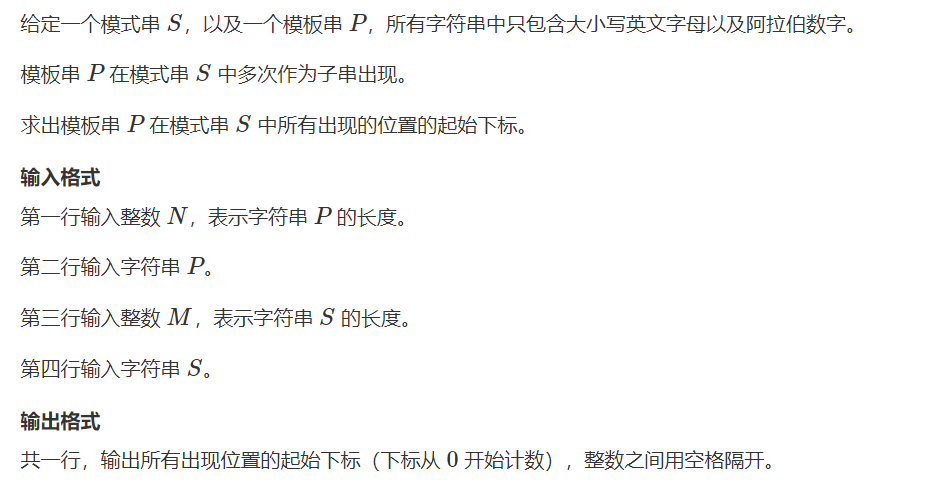
代码为:
1
2
3
4
5
6
7
8
9
10
11
12
13
14
15
16
17
18
19
20
21
22
23
24
25
26
27
28
29
30
31
32
33
34
35
36
37
38
39
40
41
42
43
44
45
46
47
48
49
| import java.io.*;
import java.util.*;
public class Main{
static int N = 100010;
static int M = 1000010;
static int ne[] = new int[N];
static char s[] = new char[M];
static char p[] = new char[N];
public static void main(String[] args) throws Exception {
BufferedReader br = new BufferedReader(new InputStreamReader(System.in));
PrintWriter pw = new PrintWriter(new BufferedWriter(new OutputStreamWriter(System.out)));
int pn = Integer.parseInt(br.readLine());
String pp = br.readLine();
for (int i = 1;i<=pn;i++){
p[i] = pp.charAt(i-1);
}
int sm = Integer.parseInt(br.readLine());
String ss = br.readLine();
for (int i = 1;i<=sm;i++){
s[i] = ss.charAt(i-1);
}
for(int i = 2 , j = 0; i <= pn ; i ++ ){
while(j > 0 && p[i] != p[j+1]) j = ne[j];
if(p[i] == p[j+1]) j ++ ;
ne[i] = j;
}
for(int i = 1 ,j = 0 ; i <= sm ; i ++ ){
while(j > 0 && s[i] != p[j+1]) j = ne[j];
if(s[i] == p[j+1]) j++;
if(j == pn){
pw.write((i - pn) + " ");
j = ne[j];
}
}
pw.flush();
}
}
|
Trie树
Trie树又称字典树、单词查找树。是一种能够高效存储和查找字符串集合的数据结构。
存储字符串:
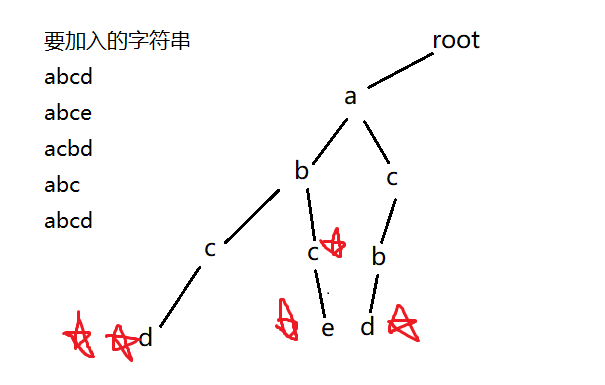
Trie树的代码具体分析:
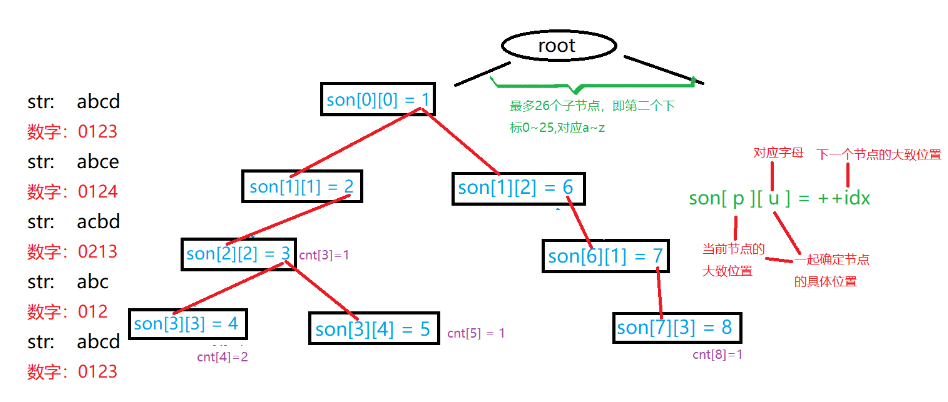
模板代码“:
1
2
3
4
5
6
7
8
9
10
11
12
13
14
15
16
17
18
19
20
21
22
23
24
25
26
27
28
29
| static int N = 10010;
static int son[][] = new int[N][26];
static int cnt[] = new int[N];
static int idx = 0;
public static void insert(String s){
int len = s.length();
int p = 0;
for (int i = 0;i<len;i++){
int u = s.charAt(i)-'a';
if (son[p][u]==0) son[p][u] = ++idx;
p = son[p][u];
}
cnt[p]++;
}
public static void query(String s){
int len = s.length();
int p = 0;
for (int i = 0;i<len;i++){
int u = s.charAt(i)-'a';
if (son[p][u]==0){
System.out.println(0);
return;
}
p = son[p][u];
}
System.out.println(cnt[p]);
}
|
例题;
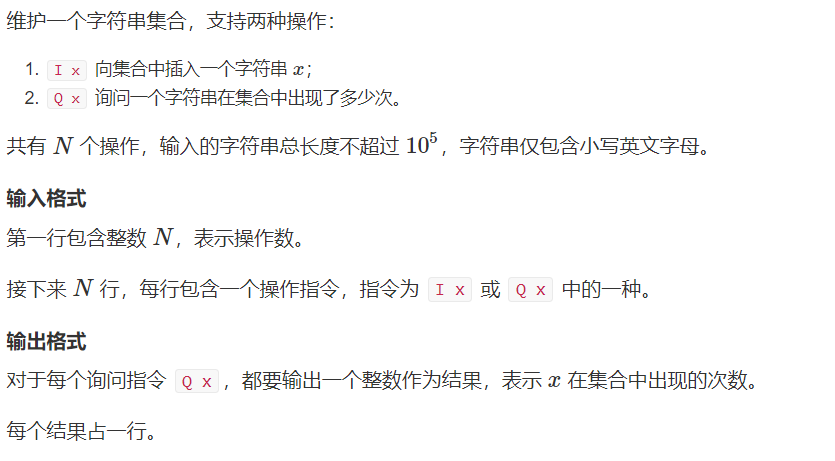
代码为:
1
2
3
4
5
6
7
8
9
10
11
12
13
14
15
16
17
18
19
20
21
22
23
24
25
26
27
28
29
30
31
32
33
34
35
36
37
38
39
40
41
42
43
44
45
| import java.util.*;
import java.io.*;
public class Main{
static int N = 10010;
static int son[][] = new int[N][26];
static int cnt[] = new int[N];
static int idx = 0;
public static void insert(String s){
int len = s.length();
int p = 0;
for (int i = 0;i<len;i++){
int u = s.charAt(i)-'a';
if (son[p][u]==0) son[p][u] = ++idx;
p = son[p][u];
}
cnt[p]++;
}
public static void query(String s){
int len = s.length();
int p = 0;
for (int i = 0;i<len;i++){
int u = s.charAt(i)-'a';
if (son[p][u]==0){
System.out.println(0);
return;
}
p = son[p][u];
}
System.out.println(cnt[p]);
}
public static void main(String[] args) throws Exception {
BufferedReader br = new BufferedReader(new InputStreamReader(System.in));
int n = Integer.parseInt(br.readLine());
while (n-->0){
String p[] = br.readLine().split(" ");
if (p[0].equals("I")) insert(p[1]);
else if (p[0].equals("Q")) {
query(p[1]);
}
}
}
}
|
并查集
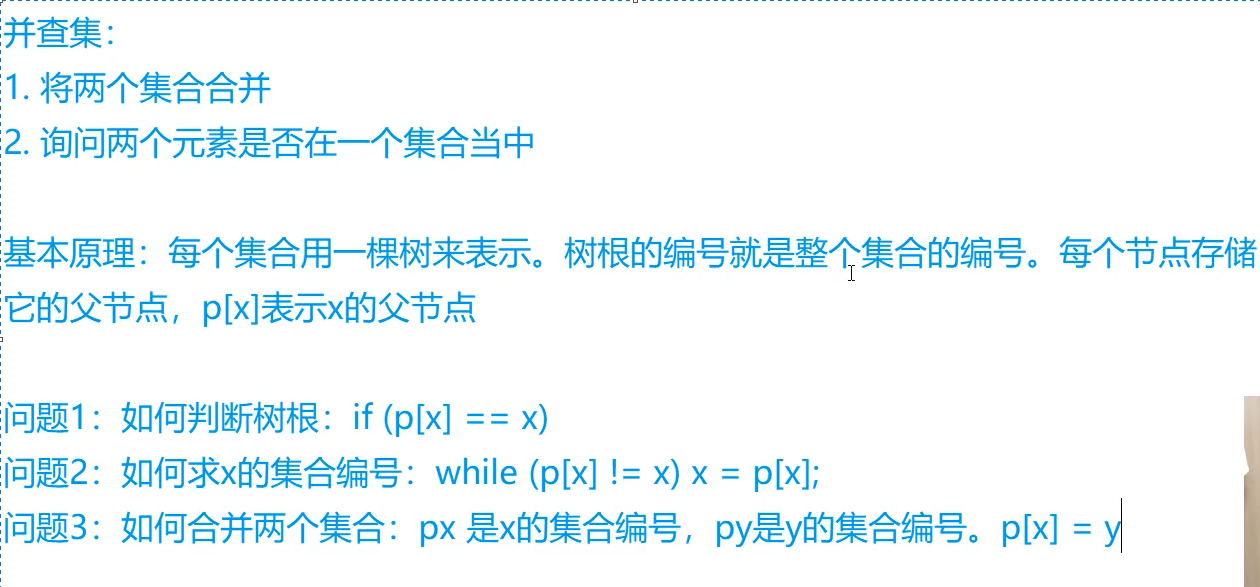
在上述的问题中,问题2的时间复杂度较高,因为遍历集合编号,只要是和数的高度成正比的,因此每次遍历需要很多的时间复杂度,因此可以进行优化。
路径压缩优化:
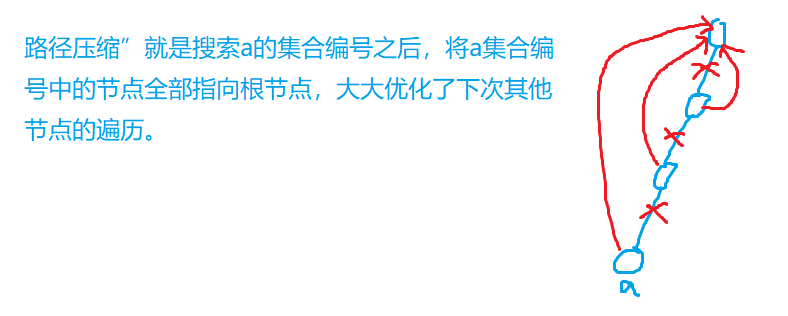
代码模板:
一:朴素并查集
1
2
3
4
5
6
7
8
9
10
11
12
13
| static int p[] = new int[N];
public static int find(int x){
if (p[x]!=x) p[x] = find(p[x]);
return p[x];
}
for (int i =0;i<n;i++){ p[i] = i;}
p[find(a)] = find(b);
|
二:维护集合里面元素的个数
1
2
3
4
5
6
7
8
9
10
11
12
13
14
15
16
17
| static int p[] = new int[N];
static int size[] = new int[N];
public static int find(int x){
if (p[x]!=x) p[x] = find(p[x]);
return p[x];
}
for (int i =0;i<n;i++){
p[i] = i;
size[i] = 1;
}
if(find(a)!=find(b)) size[find(b)] += size[find(a)];
p[find(a)] = find(b);
|
连通块:如果可以从A走到B。并且B也可以走到A,就说明A和B在同一个连通块当中的。
三:维护到根节点距离的并查集
1
2
3
4
5
6
7
8
9
10
11
12
13
14
15
16
17
18
19
20
21
22
23
| int p[N], d[N];
int find(int x)
{
if (p[x] != x)
{
int u = find(p[x]);
d[x] += d[p[x]];
p[x] = u;
}
return p[x];
}
for (int i = 1; i <= n; i ++ )
{
p[i] = i;
}
p[find(a)] = find(b);
|
例题:
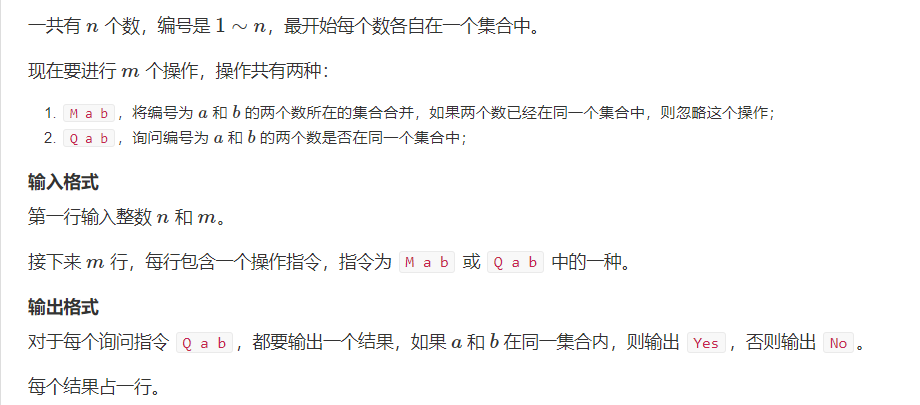
代码为:
1
2
3
4
5
6
7
8
9
10
11
12
13
14
15
16
17
18
19
20
21
22
23
24
25
26
27
28
29
30
31
32
33
34
| import java.util.*;
import java.io.*;
public class Main{
static int N = 100010;
static int p[] = new int[N];
public static int find(int x){
if (p[x]!=x) p[x] = find(p[x]);
return p[x];
}
public static void main(String[] args) throws Exception {
BufferedReader br = new BufferedReader(new InputStreamReader(System.in));
PrintWriter pw = new PrintWriter(new BufferedWriter(new OutputStreamWriter(System.out)));
String s[] = br.readLine().split(" ");
int n = Integer.parseInt(s[0]);
int m = Integer.parseInt(s[1]);
for (int i =0;i<n;i++){
p[i] = i;
}
while (m-->0){
String ss[] = br.readLine().split(" ");
if (ss[0].equals("M")){
int a = Integer.parseInt(ss[1]);
int b = Integer.parseInt(ss[2]);
p[find(a)] = find(b);
}else {
int a = Integer.parseInt(ss[1]);
int b = Integer.parseInt(ss[2]);
if (find(a)==find(b)) pw.println("Yes");
else pw.println("No");
}
}
pw.flush();
}
}
|
例题2:连通块中点的数量
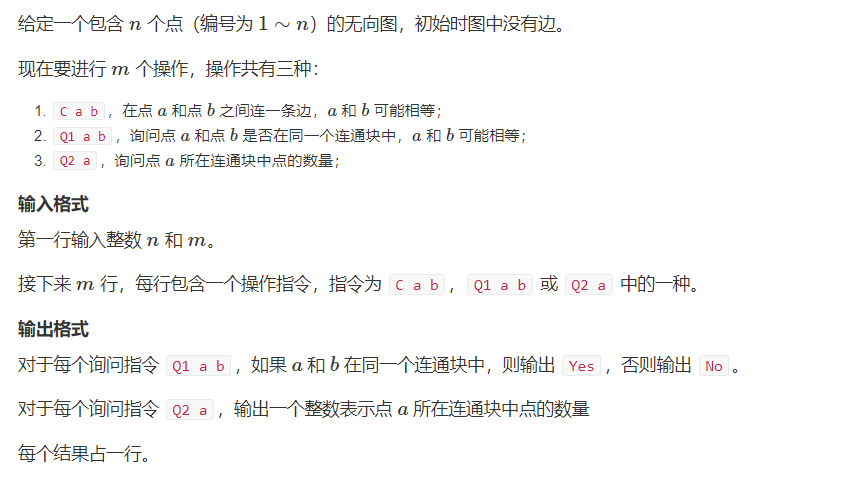
代码为:
1
2
3
4
5
6
7
8
9
10
11
12
13
14
15
16
17
18
19
20
21
22
23
24
25
26
27
28
29
30
31
32
33
34
35
36
37
38
39
40
41
42
43
| import java.util.*;
import java.io.*;
public class Main{
static int N = 100010;
static int p[] = new int[N];
static int size[] = new int[N];
public static int find(int x){
if (p[x]!=x) p[x] = find(p[x]);
return p[x];
}
public static void main(String[] args) throws IOException {
Scanner scanner = new Scanner(System.in);
int n = scanner.nextInt();
int m = scanner.nextInt();
for (int i = 0;i<n;i++){
p[i] = i;
size[i] = 1;
}
while (m-->0){
String ss = scanner.next();
if (ss.equals("C")) {
int a = scanner.nextInt();
int b = scanner.nextInt();
if (find(a)==find(b)) continue;
else {
size[find(b)] = size[find(b)] + size[find(a)];
p[find(a)] = find(b);
}
}else if (ss.equals("Q1")){
int a = scanner.nextInt();
int b = scanner.nextInt();
if (find(a)==find(b)){
System.out.println("Yes");
}else {
System.out.println("No");
}
}else {
int a = scanner.nextInt();
System.out.println(size[find(a)]);
}
}
}
}
|
例题3:
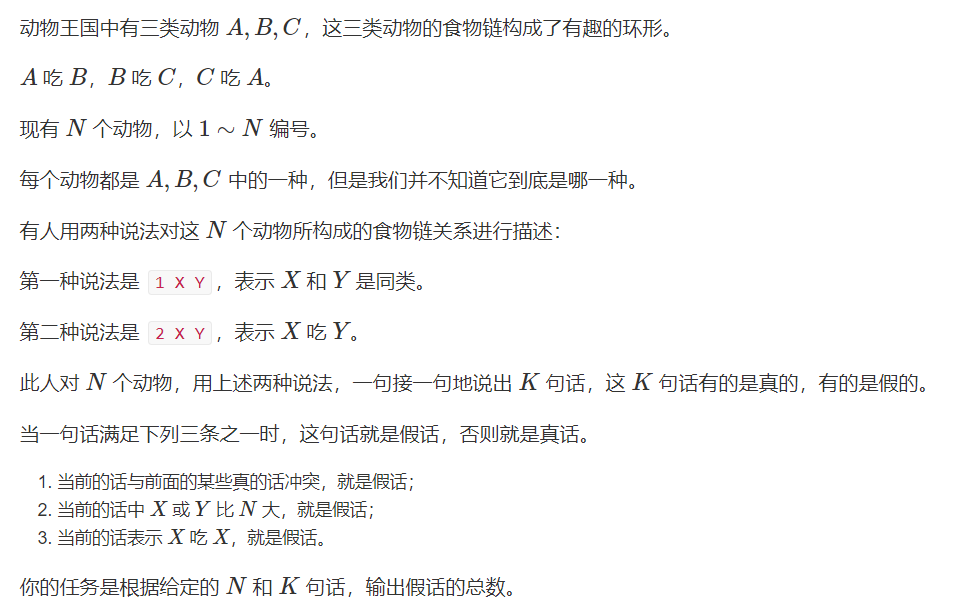
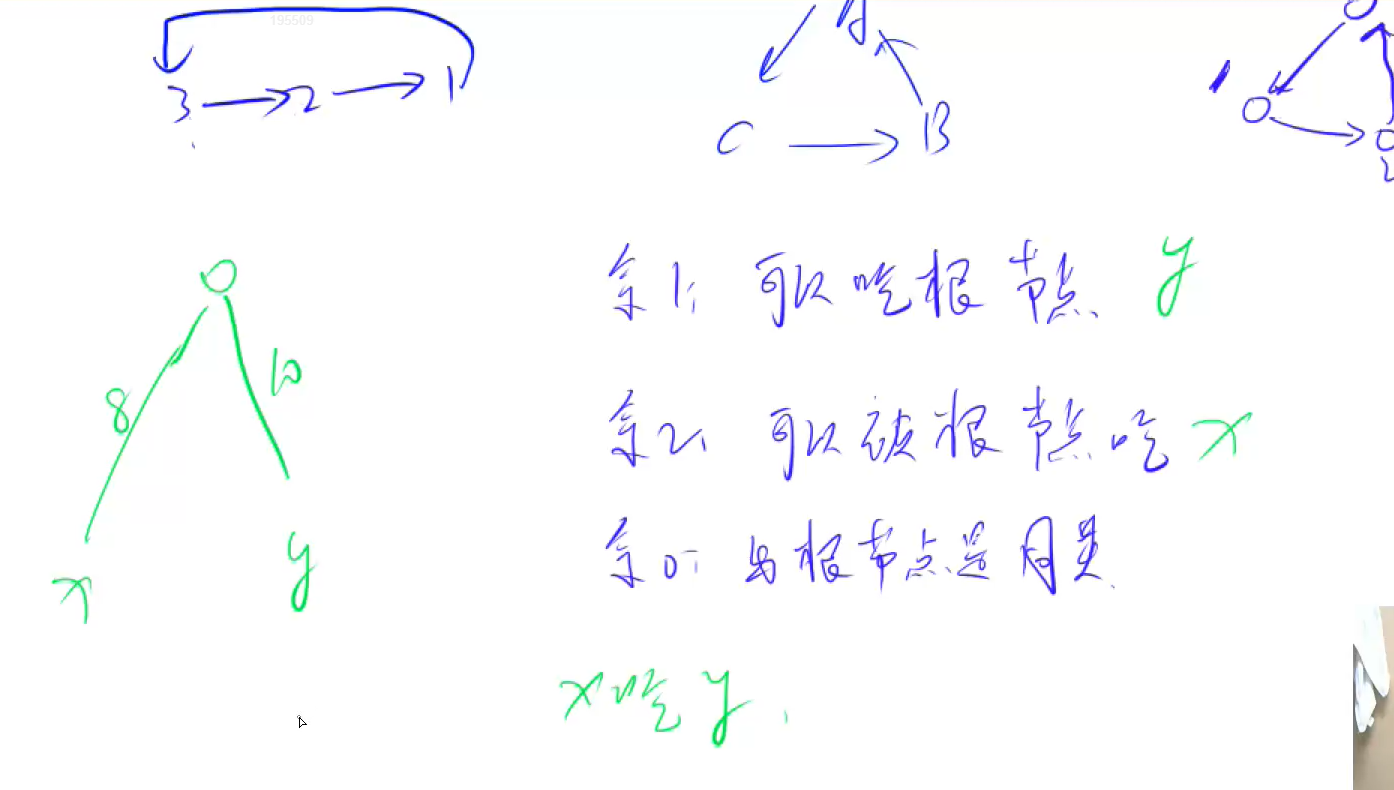
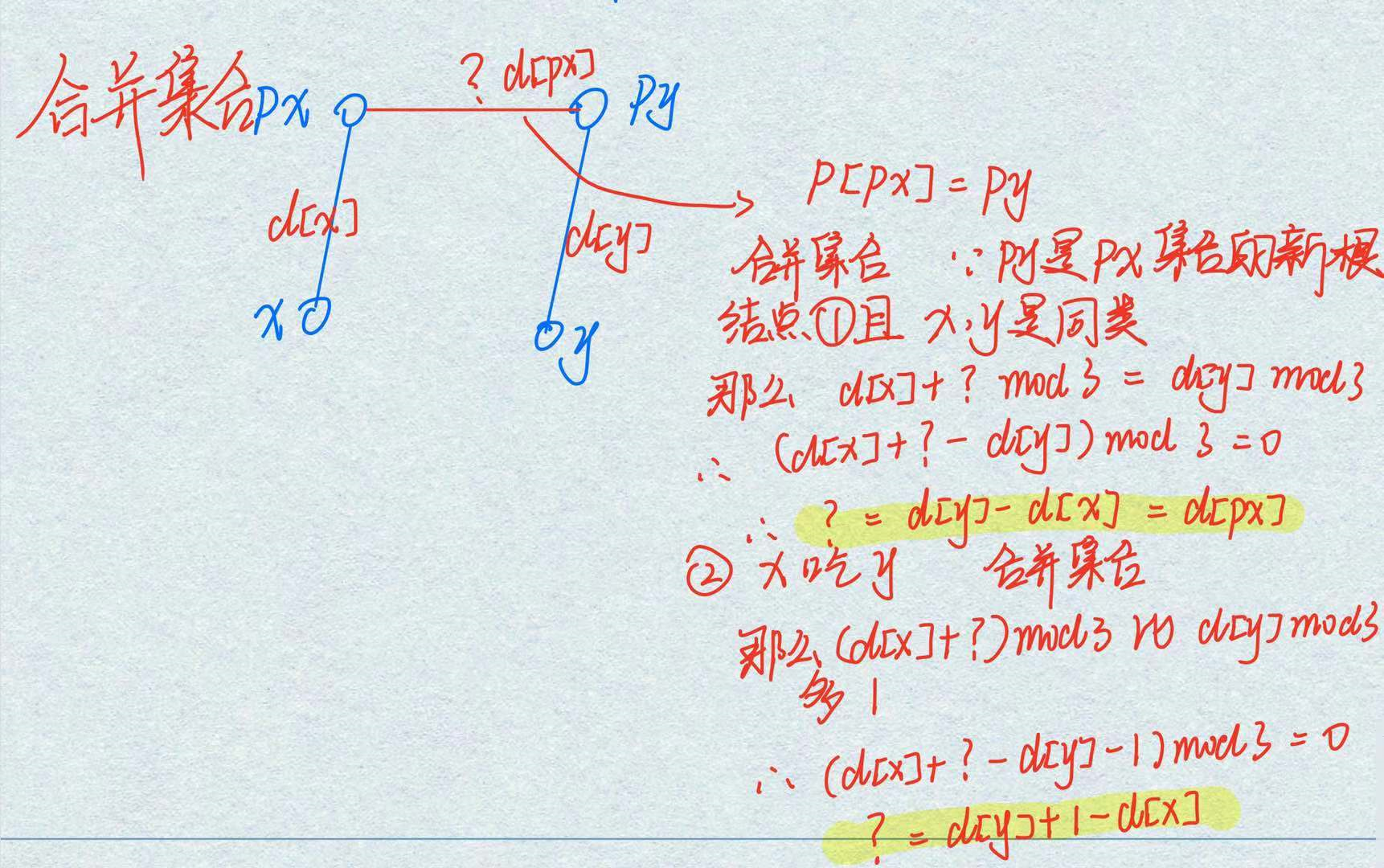
代码为:
1
2
3
4
5
6
7
8
9
10
11
12
13
14
15
16
17
18
19
20
21
22
23
24
25
26
27
28
29
30
31
32
33
34
35
36
37
38
39
40
41
42
43
44
45
46
47
48
49
50
51
52
53
54
55
56
| import java.util.*;
import java.io.*;
public class Main{
static int N = 50010;
static int p[] = new int[N];
static int d[] = new int[N];
public static int find(int x){
if (p[x]!=x){
int t = find(p[x]);
d[x] = d[x] + d[p[x]];
p[x] = t;
}
return p[x];
}
public static void main(String[] args) throws Exception {
BufferedReader br = new BufferedReader(new InputStreamReader(System.in));
PrintWriter pw = new PrintWriter(new BufferedWriter(new OutputStreamWriter(System.out)));
String s[] = br.readLine().split(" ");
int n = Integer.parseInt(s[0]);
int k = Integer.parseInt(s[1]);
for (int i = 0;i<n;i++) p[i] = i;
int res = 0;
while (k-- >0){
String s2[] = br.readLine().split(" ");
int t = Integer.parseInt(s2[0]);
int a = Integer.parseInt(s2[1]);
int b = Integer.parseInt(s2[2]);
if (a>n || b>n) res++;
else{
int pa = find(a);
int pb = find(b);
if (t==1){
if (pa==pb && (d[a]-d[b])%3!=0) res++;
else if(pa!=pb){
p[pa] = pb;
d[pa] = d[b] - d[a];
}
}else {
if (pa==pb && (d[a]-d[b]-1)%3!=0) res++;
else if(pa!=pb){
p[pa] = pb;
d[pa] = d[b] - d[a] + 1;
}
}
}
}
pw.println(res);
pw.flush();
}
}
|
堆
其中堆中包含两个操作,一个是down,另一个是up。
down:当修改堆中的数字使其变大的时候,进行down操作,将该节点的根,左子树,右子树,进行比较,如果左右子节点比修改后的小,则与最小的数进行交换,。依次进行这个操作,直到又形成一个堆。
up:当变小一个堆中的数字。进行up操作,与它的根节点进行比较,如果小于根节点,则交换,依次比较。
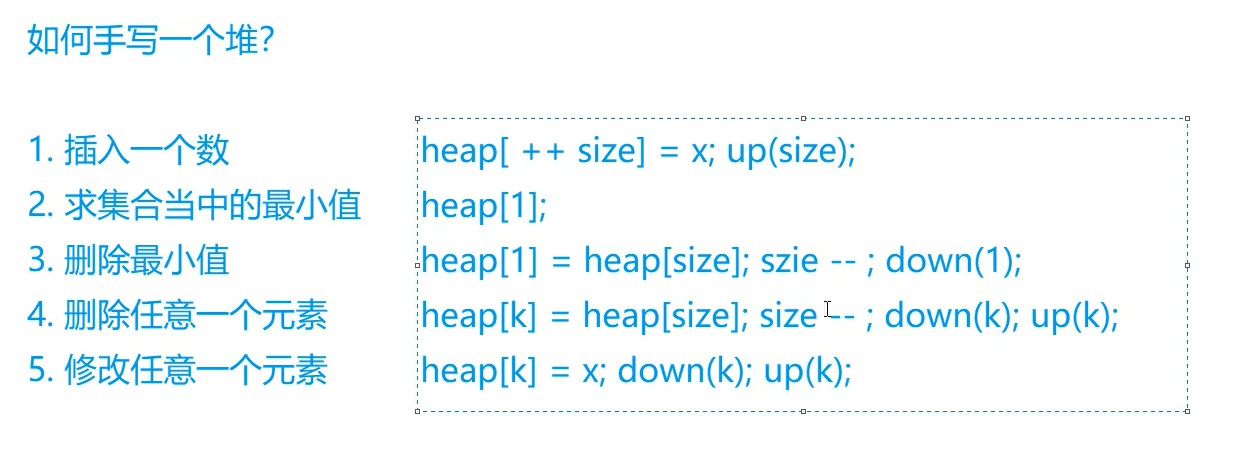
在数组中,如果根的下标为x,则根的左儿子下标为2x,根的右儿子下标为2x+1。
ph[k] = u:第k个插入的数,在堆中的下标是u;
hp[u] = k:堆中下标为u的,是第k个插入的数;















